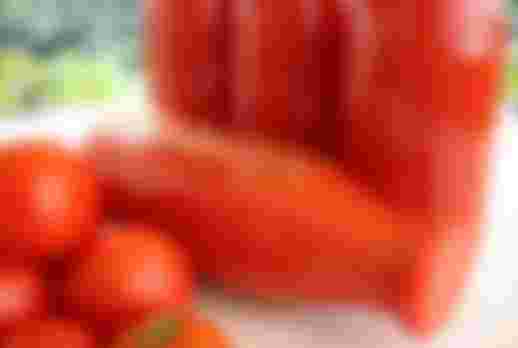
Unlike other fruits and vegetables, where the nutritional value is reduced by heat treatment, cooking tomatoes increases the concentration of bio-available lycopene.

Lycopene is a phyto-chemical, a red pigment naturally present in many foods. Chemically, it is carotene, but its action is not like that of vitamin A. It is not soluble in water, but it is soluble in fats. First you will find it in red plant foods -
tomato (2.3 mg / 100 g),
red carrot, watermelon (13 mg / slice),
red grapefruit and red orange,
papaya,
goji berries,
pomegranate.
I hope you didn’t think all red contained lycopene. Strawberries, currants, cherries, cherries… do not contain it.
Due to its structure, lycopene absorbs all wavelengths except the longest, red, so it has such a color. He was isolated 90 years ago. However, there are also foods that do not look red, and contain significant amounts of lycopene:
olive,
guava,
asparagus (lycopene content 0.3 mg / g),
parsley and basil (lycopene content 3.5–7.0 µg / g).
Unlike other fruits and vegetables, where the nutritional value is reduced by heat treatment, cooking tomatoes increases the concentration of bio-available lycopene. In tomato puree, lycopene has as much as four times higher concentration than in fresh tomatoes. Processed tomato products such as pasteurized tomato juice, soup, sauce and ketchup contain a higher concentration of lycopene compared to raw tomatoes.

Due to its strong red color, lycopene is used in the food industry as a food coloring agent called E160d. If you have ever cooked tomato sauce and used a plastic or wooden spoon, you will remember that orange or yellow spots remain on it after that, which is a consequence of lycopene entering the porous material such as plastic, wood, etc. Stains are removed by immersing the welder in an aqueous solution with bleach.
A 2017 study found that tomato products, ie the active substance lycopene, have certain positive effects on reducing cardiovascular risk factors, such as elevated blood lipids and blood pressure.

Lycopene is non-toxic and is often found in the diet, mainly in tomato products. There are cases of intolerance or allergic reactions that can cause diarrhea, nausea, abdominal pain or cramps, gas and loss of appetite. Lycopene may increase the risk of bleeding if taken with anticoagulants. Because it can lower blood pressure, it is possible to interact with drugs that affect blood pressure.




i ja sa jajima..i koju papriku i luk..njami. A za zimu zamrnem cjele rajčice. Odlično se tako ohrane.